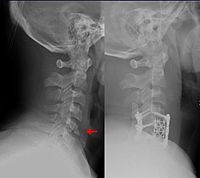
Photo from wikipedia
Supplemental Digital Content is Available in the Text. Objectives: To demonstrate the gender distribution in leadership positions and academic promotion of Orthopaedic Trauma Association (OTA) members. Methods: We conducted a… Click to show full abstract
Supplemental Digital Content is Available in the Text. Objectives: To demonstrate the gender distribution in leadership positions and academic promotion of Orthopaedic Trauma Association (OTA) members. Methods: We conducted a cross-sectional examination of the 2020–2021 OTA membership cohort dataset provided by the OTA. Professional and academic information of OTA members at their site of appointment was also abstracted from publicly available online resources. Data included: gender, OTA membership category, OTA leadership position, trauma fellowship completion, trauma practice setting, level of trauma center, percentage of trauma work, year of first practice, academic rank, and university/hospital/institutional leadership role. Statistical analysis included chi-squared, Wilcoxon two-sample, and Fisher exact tests. Results: 2608 OTA members were identified; 14.1% were women. Female representation was highest in the Trauma Practice Professional category (67.1%) and significantly lower in the Active category (9.1%) (P < 0.0001). No statistically significant gender differences were observed regarding level of trauma center, percentage of trauma work, or trauma practice setting. In the Active, Clinical and Emeritus categories, men achieved a higher level of academic rank than women at their site of employment (P = 0.003), while more men completed trauma fellowships (P = 0.004) and had been in practice for significantly longer (P < 0.0001). Men held more of the highest leadership positions (eg, Board of Directors) (P = 0.0047) and the greatest number of leadership positions (P = 0.017) within the OTA compared with women. Conclusion: Gender disparity exists within the upper echelon of leadership and academic representation in orthopaedic trauma. Our findings will help inform strategic policies to address gender diversity within the OTA and the broader orthopaedic trauma subspecialty.
Journal Title: Journal of Orthopaedic Trauma
Year Published: 2023
Link to full text (if available)
Share on Social Media: Sign Up to like & get
recommendations!